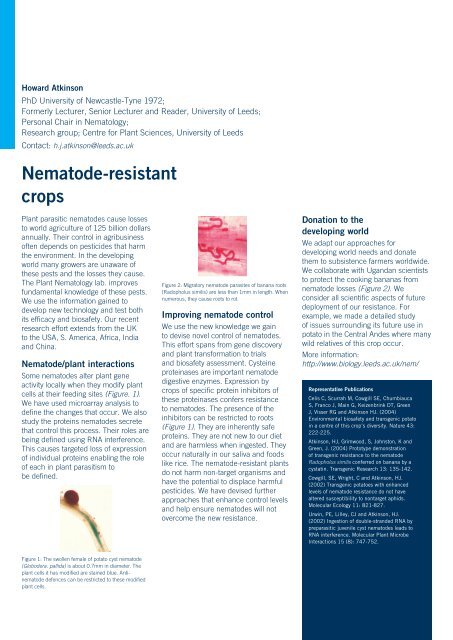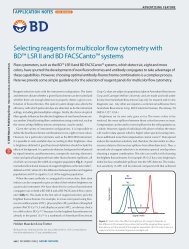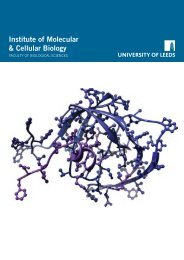3649-08 IICB.indd - Faculty of Biological Sciences - University of ...
3649-08 IICB.indd - Faculty of Biological Sciences - University of ...
3649-08 IICB.indd - Faculty of Biological Sciences - University of ...
Create successful ePaper yourself
Turn your PDF publications into a flip-book with our unique Google optimized e-Paper software.
Howard Atkinson<br />
PhD <strong>University</strong> <strong>of</strong> Newcastle-Tyne 1972;<br />
Formerly Lecturer, Senior Lecturer and Reader, <strong>University</strong> <strong>of</strong> Leeds;<br />
Personal Chair in Nematology;<br />
Research group; Centre for Plant <strong>Sciences</strong>, <strong>University</strong> <strong>of</strong> Leeds<br />
Contact: h.j.atkinson@leeds.ac.uk<br />
Nematode-resistant<br />
crops<br />
Plant parasitic nematodes cause losses<br />
to world agriculture <strong>of</strong> 125 billion dollars<br />
annually. Their control in agribusiness<br />
<strong>of</strong>ten depends on pesticides that harm<br />
the environment. In the developing<br />
world many growers are unaware <strong>of</strong><br />
these pests and the losses they cause.<br />
The Plant Nematology lab. improves<br />
fundamental knowledge <strong>of</strong> these pests.<br />
We use the information gained to<br />
develop new technology and test both<br />
its efficacy and biosafety. Our recent<br />
research effort extends from the UK<br />
to the USA, S. America, Africa, India<br />
and China.<br />
Nematode/plant interactions<br />
Some nematodes alter plant gene<br />
activity locally when they modify plant<br />
cells at their feeding sites (Figure. 1).<br />
We have used microarray analysis to<br />
define the changes that occur. We also<br />
study the proteins nematodes secrete<br />
that control this process. Their roles are<br />
being defined using RNA interference.<br />
This causes targeted loss <strong>of</strong> expression<br />
<strong>of</strong> individual proteins enabling the role<br />
<strong>of</strong> each in plant parasitism to<br />
be defined.<br />
Figure 2: Migratory nematode parasites <strong>of</strong> banana roots<br />
(Radopholus similis) are less than 1mm in length. When<br />
numerous, they cause roots to rot.<br />
Improving nematode control<br />
We use the new knowledge we gain<br />
to devise novel control <strong>of</strong> nematodes.<br />
This effort spans from gene discovery<br />
and plant transformation to trials<br />
and biosafety assessment. Cysteine<br />
proteinases are important nematode<br />
digestive enzymes. Expression by<br />
crops <strong>of</strong> specific protein inhibitors <strong>of</strong><br />
these proteinases confers resistance<br />
to nematodes. The presence <strong>of</strong> the<br />
inhibitors can be restricted to roots<br />
(Figure 1). They are inherently safe<br />
proteins. They are not new to our diet<br />
and are harmless when ingested. They<br />
occur naturally in our saliva and foods<br />
like rice. The nematode-resistant plants<br />
do not harm non-target organisms and<br />
have the potential to displace harmful<br />
pesticides. We have devised further<br />
approaches that enhance control levels<br />
and help ensure nematodes will not<br />
overcome the new resistance.<br />
Donation to the<br />
developing world<br />
We adapt our approaches for<br />
developing world needs and donate<br />
them to subsistence farmers worldwide.<br />
We collaborate with Ugandan scientists<br />
to protect the cooking bananas from<br />
nematode losses (Figure 2). We<br />
consider all scientific aspects <strong>of</strong> future<br />
deployment <strong>of</strong> our resistance. For<br />
example, we made a detailed study<br />
<strong>of</strong> issues surrounding its future use in<br />
potato in the Central Andes where many<br />
wild relatives <strong>of</strong> this crop occur.<br />
More information:<br />
http://www.biology.leeds.ac.uk/nem/<br />
Representative Publications<br />
Celis C, Scurrah M, Cowgill SE, Chumbiauca<br />
S, Franco J, Main G, Keizenbrink DT, Green<br />
J, Visser RG and Atkinson HJ. (2004)<br />
Environmental biosafety and transgenic potato<br />
in a centre <strong>of</strong> this crop’s diversity. Nature 43:<br />
222-225.<br />
Atkinson, HJ, Grimwood, S, Johnston, K and<br />
Green, J. (2004) Prototype demonstration<br />
<strong>of</strong> transgenic resistance to the nematode<br />
Radopholus similis conferred on banana by a<br />
cystatin. Transgenic Research 13: 135-142.<br />
Cowgill, SE, Wright, C and Atkinson, HJ.<br />
(2002) Transgenic potatoes with enhanced<br />
levels <strong>of</strong> nematode resistance do not have<br />
altered susceptibility to nontarget aphids.<br />
Molecular Ecology 11: 821-827.<br />
Urwin, PE, Lilley, CJ and Atkinson, HJ.<br />
(2002) Ingestion <strong>of</strong> double-stranded RNA by<br />
preparasitic juvenile cyst nematodes leads to<br />
RNA interference. Molecular Plant Microbe<br />
Interactions 15 (8): 747-752.<br />
Figure 1: The swollen female <strong>of</strong> potato cyst nematode<br />
(Globodera. pallida) is about 0.7mm in diameter. The<br />
plant cells it has modifi ed are stained blue. Antinematode<br />
defences can be restricted to these modifi ed<br />
plant cells.










